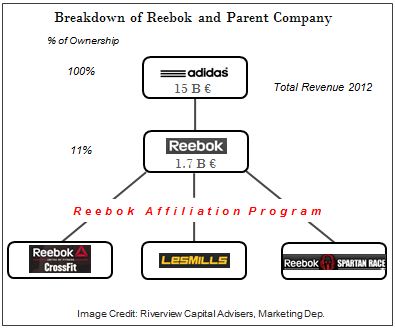Winston and Waldorf: Power of Quality
January 22, 2014529 Plan
January 27, 2014Brand Synergy
Successful co-branding, and branding in general, is living the brands; passion for the brands; and each company believing in the other’s brand. There needs to be an alignment with the prospective company. For example, Reebok and CrossFit are in the same industry, and have similar core values and cultures. Both companies value group fitness, viewing it as a lifestyle, and envision incorporating fitness into the lives of others, externally with consumers and internally with employees. Reebok has more than 1,000 employees who participate in the CrossFit Games or are ‘CrossFitters’ on a weekly basis. Prior to striking a deal with Reebok, CrossFit had been approached by other major companies over the years but hadn’t found the right fit until Reebok came along, according to Jimi Letchford, CrossFit’s chief of branding. “We started talking with Reebok, and it turned out that their chief marketing officer, their head of sports and fitness, and a number of their athlete ambassadors were CrossFitters,” says Letchford, noting, “That really hit home with us” (11).
If we compare Reebok’s Mission & Values with the beliefs of CrossFit we see meaningful synergies between the two companies which helps promote a successful and mutually beneficial co-branding strategy.
Know Your Partner
 It is important to get to know your co-branding partner. If they are involved in other co-branding agreements, you should learn about their other partners as well. As in any licensing opportunity, track record and market penetration are key components. In addition, it is also important to understand that more involvement may not be better from a liability perspective. For example, entering a new industry may entangle your company in unfamiliar government regulations. Sometimes, a co-branding deal should be just that, rather than an opportunity for companies to combine operations or involve each other extensively in production or manufacturing processes.
It is important to get to know your co-branding partner. If they are involved in other co-branding agreements, you should learn about their other partners as well. As in any licensing opportunity, track record and market penetration are key components. In addition, it is also important to understand that more involvement may not be better from a liability perspective. For example, entering a new industry may entangle your company in unfamiliar government regulations. Sometimes, a co-branding deal should be just that, rather than an opportunity for companies to combine operations or involve each other extensively in production or manufacturing processes.
Of equal importance is familiarizing yourself with the operations of your co-brander, especially if your co-brander is the party responsible for manufacturing or bringing the goods to market. Co-branding is sometimes an opportunity for untested brands and newer companies to make a splash in the market by aligning themselves with more prestigious brands. If your company is aligning your brand with such a company, make sure that you are comfortable with their product safety track records and OEM relationships (2).


